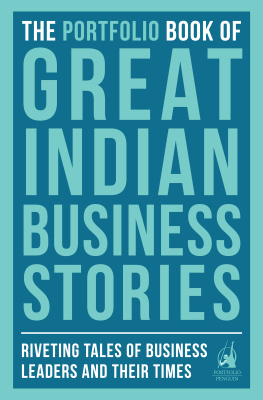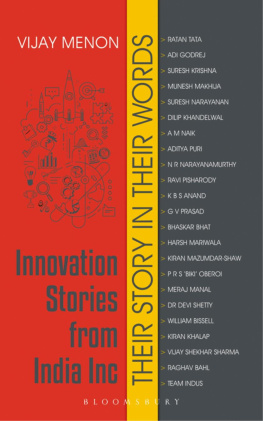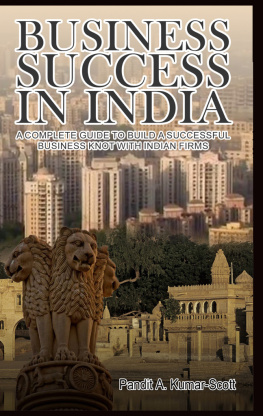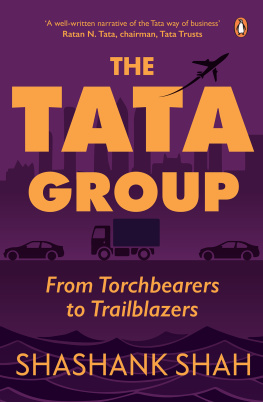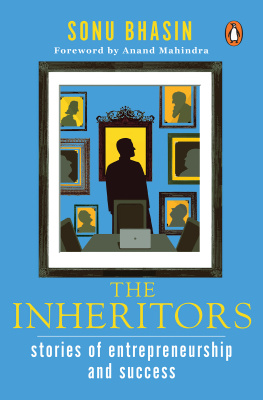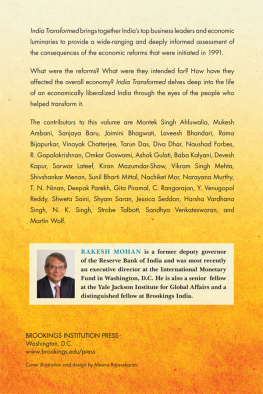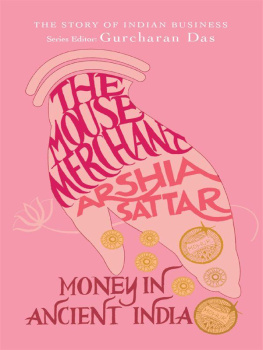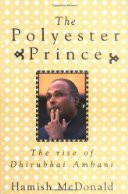Contents
THE PORTFOLIO BOOK OF GREAT INDIAN BUSINESS STORIES
Riveting Tales of Business Leaders and their Times

PENGUIN BOOKS

PENGUIN BOOKS
RAHUL BAJAJ
Excerpts from Business Maharajas by Gita Piramal
R ahul was born on June 10, 1938, in Calcutta to Savitri and Kamalnayan (19151972) Bajaj, a Marwari businessman. The family was comfortably well off and in the process of moving from trade into industry. He schooled at Bombays elite Cathedral and John Connon School, and graduated from Delhis St Stephens College with a BA (Hons) in Economics in 1958. Back in Bombay, Bajaj did a two-year stint at Bajaj Electricals, clocking in after morning lectures at the Government Law College. He spent most of 196162 as a junior purchase officer at Mukand and with some work experience under his belt, he left for Harvard. He passed out of the class of 64 with an MBA degree. In between (December 1961), he married Rupa Golap, a Maharashtrian beauty queen and an up-and-coming model. They have three children, Rajiv (b.1966), Sanjiv (b.1969) and Sunaina Kejriwal (b.1971).
Like his contemporary the late Aditya Birla, Rahul was raised in an intensely political family. Mahatma Gandhi treated his grandfather, Jamnalal Bajaj (18891942), as his fifth son. His grandfather was also a close friend of Jawaharlal Nehru. He contributed to the nationalist movement and the Congress Party, and was its treasurer for some years. The political tradition continued into the next generation. Between 1939 and 1947, most of the adult members of [the Bajaj] family found themselves behind prison bars in the cause of Indian freedom. Kamalnayan later became a Congress member of Parliament. When the Congress Party split in 1969, he left Indira Gandhi to join the Congress (O).
Though Bajaj has no personal political ambitions, he likes the company of movers and shakers. The Bajajs and the Nehrus have been family friends for over three generations. Kamalnayan and Indira Gandhi studied at the same school for a short time. Jawaharlal Nehru himself picked the name Rahul for Kamalnayans first-born, a gesture which made Indira Gandhi hopping mad as she had wanted it for her own son, recalls Rupa. (Coincidentally, Rahul and Rupa named their first-born Rajiv, and Rajiv and Sonia Gandhi named their son Rahul.) As prime minister, Rajiv Gandhi reportedly turned to Bajaj for advice. Closer home, Bajaj has been in the kitchen cabinet of Sharad Pawar, four times chief minister of Maharashtra.
Unlike Birla, however, Bajaj was brought up in a spartan atmosphere, unusual for a business family. Kamalnayan grew up in Gandhis ascetic ashram at Wardha. His children (Rahul, Suman and Shishir) grew up in relatively more luxurious surroundings, in the leafy bylanes of Bombays posh Carmichael Road. Rahuls upbringing and values owed more to Mahatma Gandhi than Jawaharlal Nehru, being more middle class than aristocratic. Holidays were often spent playing with the workers children in the familys factories. Given this background, the idea of living inside an industrial complex did not appear as ludicrous to Bajaj as it would to his peers in the Marwari aristocracy. Actions speak louder than words. I did not and do not believe in absentee landlordism, Bajaj is fond of declaring.
Bajajs first office was simple: a Godrej table, a Godrej chair, and not much else. Though I was an MBA from Harvard, I didnt have any fancy ideas that I must have staff, or a secretary, he remarks virtuously. His no-nonsense, hard-nosed, direct approach soon created an aura around Indias king of the road. It is an image which affords Bajaj immense satisfaction.
His efforts at projecting a middle-class image are, at times, a touch ridiculous. Such as the superfluous identikit badge dangling from the pocket of his half-sleeved safari suit. Why does a gold stripe embellish Bajajs laminated mugshot when those of his executives are mere silver? Would any of the security personnel have the temerity to question, let alone check, the bosss walkabouts?
Rupa chuckles at the thought. They have been living in the factory complex for almost three decades. On shifting from Bombay to Pune, they were allotted a 10' by 12' room in a Bajaj guest house. The rest of it was reserved for the general manager of Bajaj Electricals, a group company now run by Shekhar Bajaj. Dussehra 1965 saw them finally in a house of their own. Rupa has no complaints. Like her husband, she enjoys colony life despite tense moments such as those following the police firing in 1979.
That night we hardly slept. We received a couple of crank calls saying it would be better if the children and I go away, maybe to Bombay. Rahul and I thought about it. I said no. I wanted to be with Rahul and I didnt want people in the colony to think that Rahuls wife and children could just take off for Bombay when things became difficult. I also thought that if I went away, it would be a long, long time before I could come back. Once you go away in such a situation, it is very difficult to feel secure enough to come back. Since there was firing, an inquiry would take place which would be a long drawn out thing. The workers were in a mood to fight the management for a long time. I wanted to stay here with him, Rupa recalls.
But times change. The next generation has its own views. I dont think one should be rigid. There are business families who live in big cities, away from their factories. I believe it is important to know how the company works and the kind of management systems it follows, says Sanjiv. Sanjiv might have thought differently had he been in his fathers black Bally sandals on November 26, 1964, the day a twenty-six-year-old Rahul joined Bajaj Tempo Ltd.
TEMPO TANTRUMS
His first job was as a deputy general manager. I had to see the commercial side which included purchasing, marketing, sales, accounts, finance, audit, everything but the production. His boss was Naval K. Firodia (b.1910), then chief executive of Bajaj Auto and managing director of Bajaj Tempo.
Thin and ascetic-looking, his starched white khadi Nehru topi proclaiming his Gandhian convictions, Firodia was a lawyer from Ahmednagar who had spent time in Yerawada prison during the 1942 Quit India Movement, and got to know the Bajaj family in the 20s through the Congress Party. Following Independence, Firodia joined the Bajaj Group, and helped them tie up joint ventures to manufacture auto-rickshaws and scooters in India. In August 1957, Bajaj Tempo was promoted to make three-wheelers using German technology. The first Indian Vespa from Bajaj Auto operated out of a garage shed at Goregaon, on Bombays outskirts, and Bajaj Auto had its manufacturing facility at Kurla. Later both plants were shifted to Akurdi, with a grass strip separating them. Today theres a wall on this strip.

